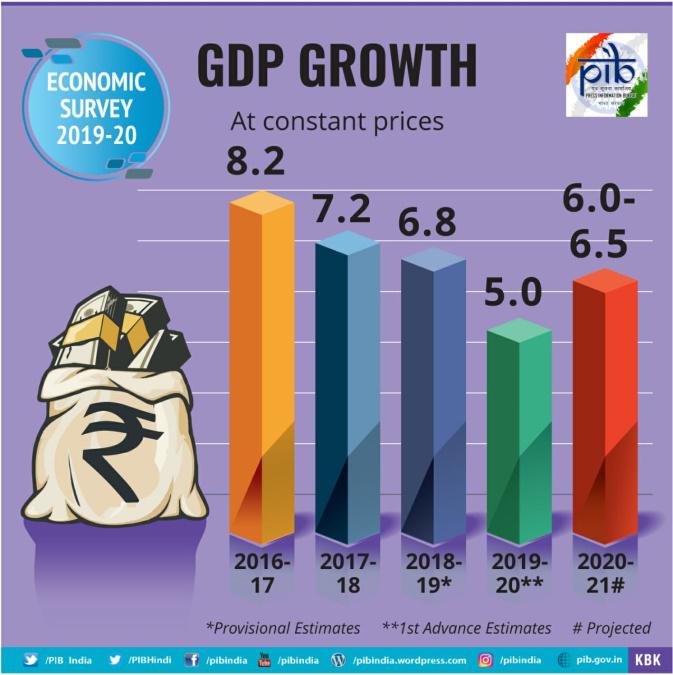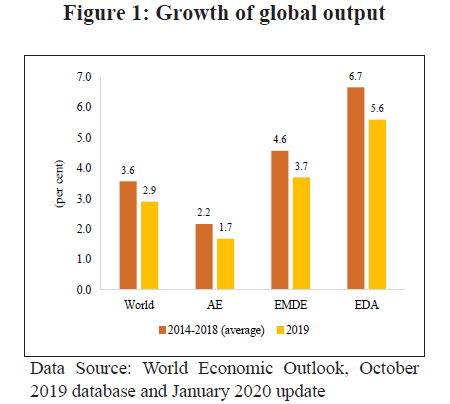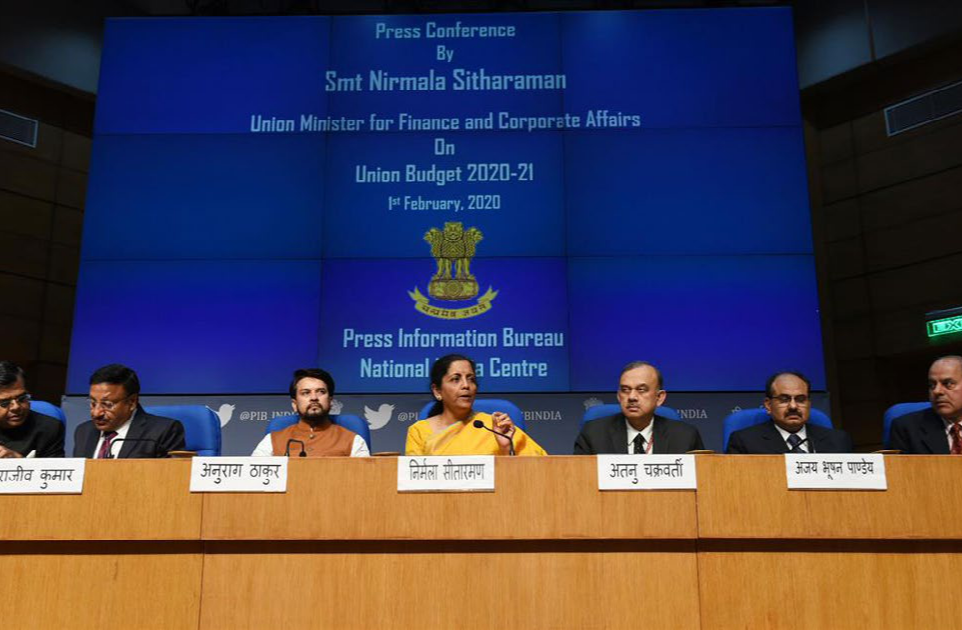Dr. Dhanpat Ram Agarwal
he Union Budget has been presented by Smt. Nirmala Sitharaman in Parliament on 01-02-2020 under a very challenging situation of economic slow down but because of sound economic management, the Macro Economic Factors are more or less under moderate condition as the average Inflation is below 5%, Fiscal Deficit within reasonable limit of 3.8% and Current Account at Deficit 1.5%,. The country is under comfortable situation with a forex reserve USD 461.2 Billion and improving FDI inflow from USD 22.6 Billion in 2018-19 (April-September) to USD 26.10 Billion in 2019-20 during April-September. The average GDP growth in Modi Government 1.0 was 7.5 percent as against Global growth of 3.6% and China 6.9% and thus India being the fastest growing nation during 2014-2019.

The economic survey has laid emphasis on Wealth Creation by invisible hands and with the hands of trust, Invisible hand implies market economy and hands of trust means believing in the business entrepreneurs. The reference has been made to glorious past of 2000 years ago when India was the richest country in the world and the references have been made to Kautilya, Thiruvallavar, and Adam Smith about the importance of free market economy based on competition. The same philosophical view is reflected in Union Budget. The Finance Minister is also hopeful for achieving the vision of the $5 trillion economy target as per the dream of Shri Narednra Modi Ji for “New India”. Therefore the biggest challenge before the Hon’ble Finance Minister was to focus as to how to boost the economy from the slowdown which creeped in since 2016-17 and became more visible in the immediately preceding 6 quarters of 2018-19 and 2019-20.
The Economic growth slowed over gradually since after 2016-17 from 8.5 to 7.2 to 6.8 to 5 per cent in 2019-20 as against the growth target of 7%. The growth target for 2020-2021 has been kept at of 6 to 6.5percent in. The quarter to quarter slowdown is visible since 2018-19 as Q1 8 to 7 to 6.6 to 5.8 in Q4 and then continued to slow down in 2019-20 to Q1 5 to Q2 4.5 per cent. However it appears that due to arrest of further decline, the growth for the full year is estimated at 5 per cent for 2019-2020.

The important question to be dwelt in this analysis is whether and how this recovery from the slowdown will take place and whether the slowdown has bottomed out at Q-2, 4.5 percent. To understand let us understand the present economic situation. The size of Indian Economy at present is US$2.9 trillion and the target of US$ 5 trillion over next 5 years by 2024-25 beginning say today or April 2020 in the next 5 years, is targeted to be achieved.
Immediately after the announcement of the 2nd quarter results of September 2019 several measures were undertaken by the Finance Minister by lowering down GST rates, lowering down Corporate Tax Rate to 22% and pumping in more liquidity in the banking sector. A Task force was constituted in September 2019 for National Infrastructure Pipe line (NIP) with investment plan of Rs 103 lakh crores over 5 years beginning 2019-2000 to 2024-2025 in certain core areas of Road, Railways, Energy, Rural Development etc. The funding for the infrastructure investment is proposed as 39% from Central Government, 39% from State Government and 22% from Private Entrepreneurs along with funding by Indian and foreign financial sectors including Sovereign Wealth Funds. A provision of Rs.22000 crore has already been made for this purpose in the Budget.
Agriculture, Industry and Services Sector contribute 16.5, 28.5 and 55 percent respectively to our national income. The growth in these sectors as estimated in 2019-20 is Agricultural 2.8, Industry 2.5 and service 6.9 per cent respectively. The dependence of population in these three sectors are broadly 60, 20 and 20 percent of our population. Therefore there is inbuilt imbalance for which there is necessity of social safety net for the Rural Poors and the Government is trying to minimise these imbalances by doubling the farmers’ incomes in the next few years, and by way of several other Rural Development Programs. There is a provision for Rs.2.83 lakh crore for Agriculture and Irrigation Sector and Rs.3.60 lakh crore for the Jal Jeevan Mission.
Now we should look at India vis a vis the global scenario. There is a global slow down due to cyclical and some geo political factors including trade war. The global economic growth has slowed down from 3.8 in 2017 to 3.6 in 2018 to 2.9 percent in 2019 and this has a correlation with Indian Economic Slowdown.

India is still the fifth largest economy after USA, China, Japan and Germany. USA $ 21.3 trillion, China $14.2 trillion, Japan $5.18 trillion, Germany $4.2 trillion and India nearly $3 trillion in 2020 as per IMF. On PPP India is the third largest with about 12.6 trillion after USA (22.2 trillion) and China(29.7 trillion). However the size of the economy is not the only indication but the other important factors are GDP per capita where India’s position is 139, Human Development Index (HDI) being 130, Global Innovation Index(GII) being 52 and Ease of Doing Business being 63.Therefore the challenge is for equitable and balance growth so that the per capita income of common man increases by reducing the income inequality and there is also the need of improvement in the quality of life of people so that India’s position increases in the Human Development Index. Similarly there is need for improvement of research in the country so that the indigenous technology can make our industrial product more qualitative and competitive in the international market.
Another important segment to achieve high growth rate is to optimise and leverage our rich human resources. According to World Bank Study Report, out of the three economic resources: Natural Resources contributes 20%, Capital Resources contributes 16% and Human Resources contributes 64%. There is need to enrich our Human Resource by educating, training, skill development and by incubation of ideas through proper research and development in order to make a robust IP eco system in the country, so asto meet the gap between Human Resource and Intellectual Resource. In the present knowledge and technology driven economy where Innovation is the key for transformation and which is causing disruptions and creation of new technological innovations every now and then, We must develop our technology to global standard. Amazon, Google, Apple, UBER, AIRBNB, Alibaba and many others are replacing the top Fortune 500 Companies graph. Artificial Intelligence with Machine Learning and Robotics, Big Data, 3D printings, Block chain technology are throwing challenges for job creation and the job loss. In such a situation the Govt. Should have allocated much higher resources for science and technology.
Under this environment the only way to develop is by Innovation and IP. USA earns US$ 6.04 trillion only from IPR which is more than the double of India’s 3 trillion economy. Intangible wealth accounts for 80% of the global wealth today. We need to make an assessment of our intellectual asset and human capital.
There is need for setting targets for making India competitive in the present global environment by manufacturing innovative and qualitative products to meet our domestic demand and to also generate exports surpluses.
Unless we do it there are adverse external factors like the present burgeoning external debt which is US$ 561 billion and the cumulative foreign portfolio investment of US$ 260 billion, and the volatility in financial and capital market which may cause another BOP crisis similar to 1991. We need to be innovative and growth centric with Rural Development, Job Creation, Removing poverty, decentralised planning at district level clusters with protection of environment and by retaining our cultural values and ethos.
Swawalamban, Swabhiman and Sovereignty should be the key to economic growth by balancing our political and social ambitions.To conclude power of ideas and power of Swadeshi technology with a strong Indian Rupee via a vis US Dollar can only make India a strong nation with strong people.
(The Writer is Senior Chartered Accountant and Director of Swadeshi Research Institute, Kolkata. The views are personal.)
(The views expressed are the author's own and do not necessarily reflect the position of the organisation)

